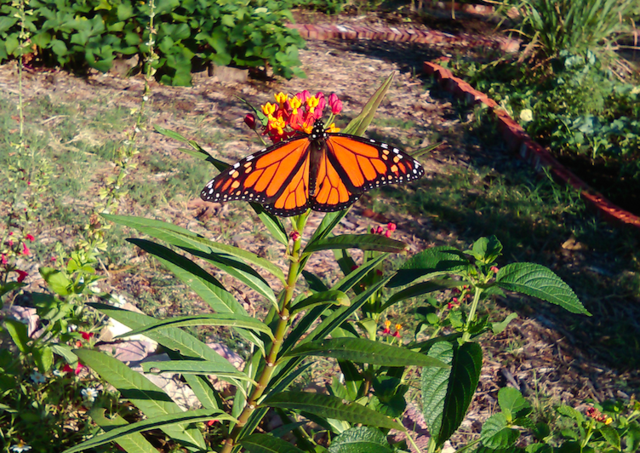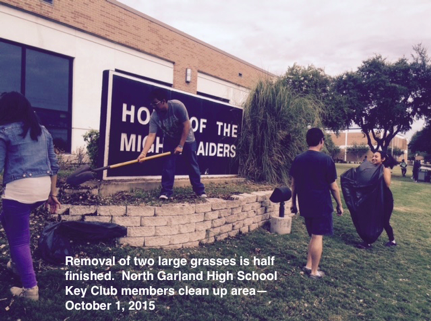BUTTERFLY GARDEN AT NORTH GARLAND HIGH SCHOOL
Today was a day for taking care of Monarch butterflies. I spent the morning in the Garland Community Garden gathering needed materials for building five hugelkulturs on Tuesday. (Tuesday October 6 at the North Garland High School will be Stage Two for the installation of a special butterfly garden. The time is 2:30 to 5:30 if you want to come help.)
What makes the installation of a Butterfly Garden at North Garland High School so special?
- It may be the first butterfly garden at any Garland public school. [If not, I’m sure to be corrected by my readers.]
- It is almost definitely the first butterfly garden in the entire DFW area that is planted in a hugelkultur. [Again, I might be corrected on this statement as well, but I doubt it.]
- It is a joint effort involving members Loving Garland Green, a 501 (c) 3 nonprofit organization and members of the North Garland High School Key Club.
So what was Stage One of this special butterfly garden build?
Stage One, on Thursday October 1, 2015, involved removing three large clumps of overgrown grasses from the central bed and seventeen Nandina shrubs and two small dead trees from the four smaller beds that are part of the area we will call the North Garland High School Butterfly Habitat. Loving Garland Green members hauled the debris to the Garland Community Garden where the grass went to one of our large compost heaps and the Nandina bushes now have a second life encircling the Children’s Garden there.
Stage Two: Hugelkultur Builds
Stage Two will take place today, October 6, 2015 between 2:30 and 6:00 PM on the front lawn of North Garland High School. During this stage we will install five hugelkultur beds. One will be installed in the large bed shown above and four in the smaller beds against to the school building.
Hugelkultur is a German word meaning mound or hill culture. These types of garden beds have been used in Germany for hundreds of years. They are a permaculture technique that replicates the natural process of decay that happens on the forest floor. Trees fall and become logs. As the logs decay, they become porous and store water and release nutrients to feed plants.
On Tuesday we will:
- Remove garden soil and place nearby on tarp.
- Pile logs (old and rotting are best) on the bottom of the bed space.
- Soak them with water.
- Add twigs
- Add leaves and brown organic matter.
- Add green organic matter (sweet potato leaves).
- Add manure.
- Add brown organic matter.
- Replace soil removed from original bed and water thoroughly.
The hugelkultur is an ongoing nurturing compost pile that continues to support and nourish plants ongoing with no water except in extreme drought without any added soil amendments for up to 20 years.
Timely Monarch Caterpillar Interruption
Monday, after gathering organic materials from the Garland Community Garden, I returned home for a drink of water before going over to Monroe Todd’s home to get some free manure from this goat farm nestled amongst the large beautiful homes of the Firewheel area here in Garland. Mr. Todd is an 87-year-old member of one of the founding families of Garland. His home is also the home of about 30 goats, numerous chickens, and a productive pecan grove. I love to visit with him as he always has at least one great story. Yesterday I learned about all the many uses of the cowboy’s bandana. I wish he would travel around to our schools telling school children his stories about Garland.
I just happened to glance at the milkweed in my back yard as I went into the kitchen and there was the second Monarch caterpillar I’ve seen in the past few weeks. It is now in the laundry basket along with the pupa of another Monarch and plenty of milkweeds to munch on.
Stage Three: Installation of Plants
Thursday October 8, from 2:30 to 5:30 PM we will install plants in the five hugelkulturs. Most of these plants are native and drought tolerant and most of them are perennials and self-seeding plants such as various milkweeds. Our butterfly garden, like all butterfly gardens, has nectar plants and host plants. Nectar plants are the food plants for the butterflies. The host plants provide the habitat for the butterfly eggs, caterpillars and pupae. Butterflies are often very specific regarding their choice of host plants. For example, the Monarchs and 300 other species of butterflies will only deposit their eggs on milkweed plants. Other butterflies such as the Gulf and Mexican Fritillaries will only deposit their eggs on the passionflower vine.
_______________________________________________________________________________________
Why build butterfly gardens or even care about these creatures?
This butterfly garden is more than a flower garden. We hope it will be an example of sustainable living and environmental awareness—from water conservation to taking action to protect pollinators by providing them with an acceptable habitat.

Monarch butterfly at the Garland Community Garden – Photo taken by Robert Opel
Two Good Reasons
First of all, our pollinators are beautiful creatures as illustrated in the photo above taken in the Garland Community Garden by Robert Opel, one of Loving Garland Green’s board members.
Second of all, as I mentioned in a previous article our pollinators—from bees to butterflies—are a critical link in our food chain.: Although some plant species rely on wind or water to transfer pollen from one flower to the next, the vast majority (almost 90%) of all plant species need the help of animals for this task. There are approximately 200,000 different species of animals around the world that act as pollinators. Of these, about 1,000 are vertebrates, such as birds, bats, and small mammals, and the rest are invertebrates, including flies, beetles, butterflies, moths, and bees. [SOURCE: Natural Resources Conservation Service, Wildlife Habitat Management Institute – Native Pollinators –
http://plants.usda.gov/pollinators/Native_Pollinators.pdf – accessed 9/29/2015













Social